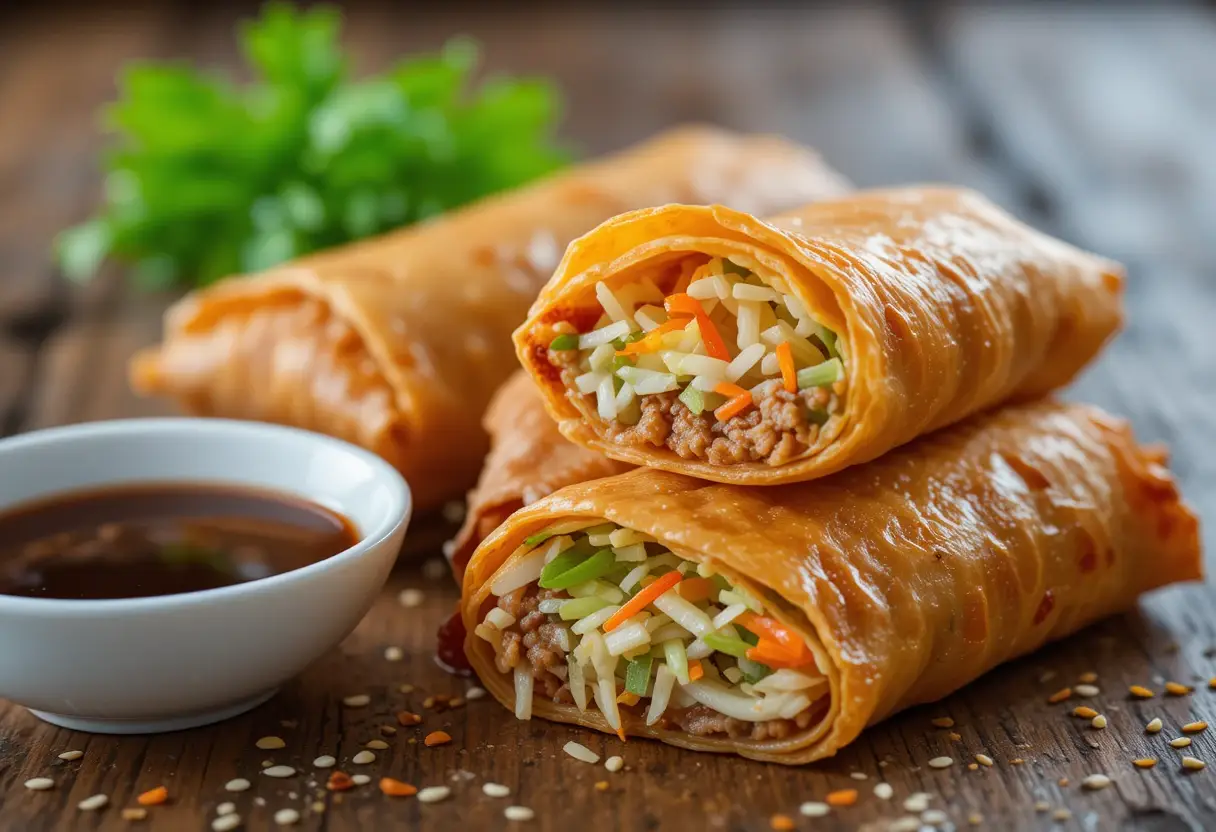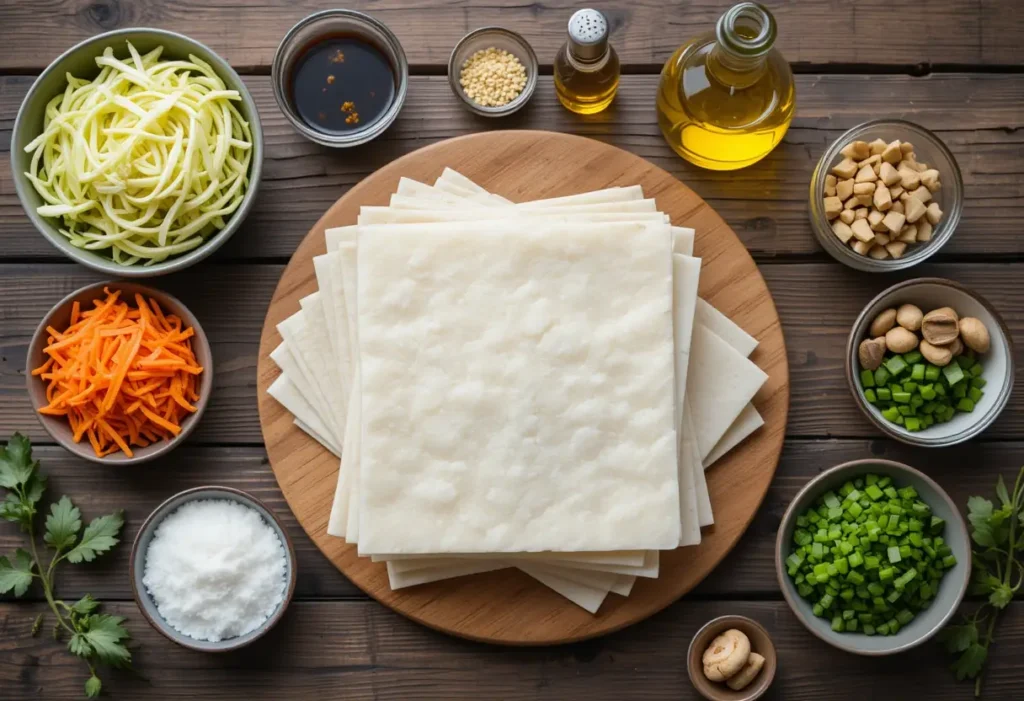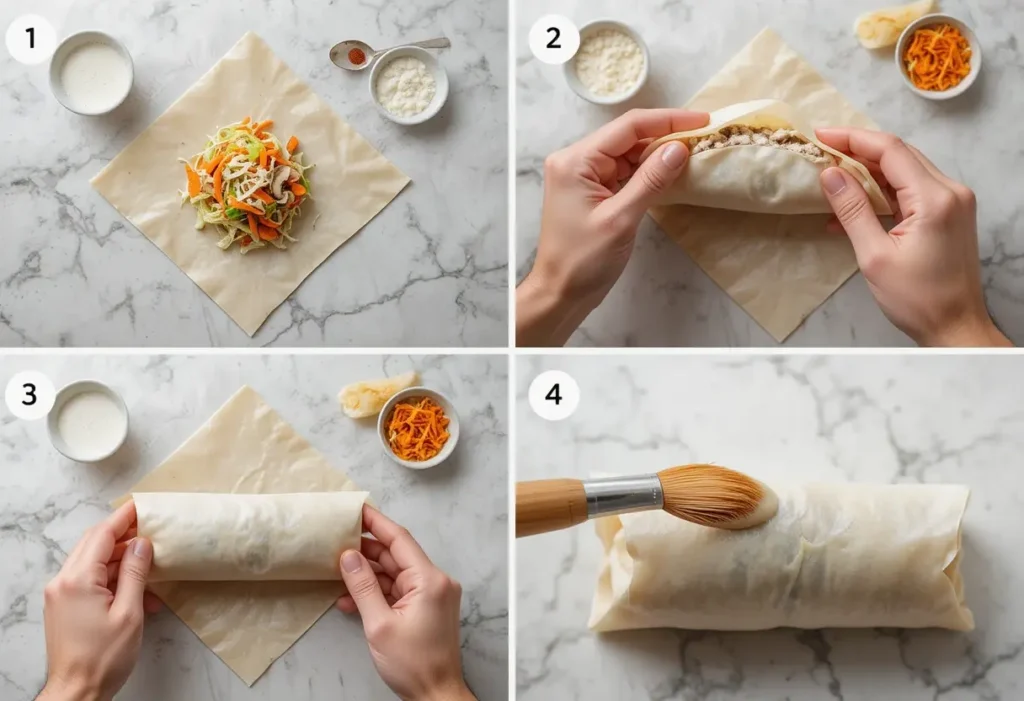Veggie egg rolls are a delightful, crunchy appetizer or snack, filled with a variety of vegetables, herbs, and spices. These versatile and customizable rolls cater to diverse taste preferences and dietary restrictions, making them a popular choice worldwide. Whether you are a seasoned cook or a kitchen novice, creating your own veggie egg rolls at home is a satisfying and fun culinary adventure.
Table of Contents
What Are Veggie Egg Rolls?
Veggie egg rolls are a type of savory pastry consisting of a thin, wheat-based wrapper filled with a mixture of vegetables such as cabbage, carrots, bean sprouts, mushrooms, and onions. These rolls are typically seasoned with soy sauce, garlic, and ginger, providing a burst of flavor in every bite. Once filled, the rolls are sealed and either fried to achieve a golden, crispy texture or baked for a lighter version.
Veggie egg rolls are often served with dipping sauces, like sweet chili, soy-based, or peanut sauce, enhancing their flavor profile. They are a staple in many cuisines and are enjoyed as appetizers, snacks, or even as a main dish.
Historical Origins and Cultural Significance
The origins of egg rolls can be traced back to ancient Chinese cuisine, where early forms of stuffed rolls were created using thin sheets of dough and filled with various ingredients. Over time, these rolls evolved into the familiar egg rolls we know today, gaining popularity across different regions of the world.
In Chinese culture, spring rolls (the precursor to egg rolls) are associated with the Lunar New Year, symbolizing prosperity and wealth. The transition to the “egg roll” version, particularly in Western countries, brought about a thicker wrapper and diverse filling options, including vegetarian varieties, reflecting global culinary influences.
Ingredients Needed
List of Essential Ingredients
To prepare delicious veggie egg rolls, you’ll need the following essential ingredients, measured for making approximately 12 rolls:
- Egg roll wrappers: 12 sheets
- Cabbage: 2 cups, finely shredded
- Carrots: 1 cup, julienned or grated
- Bean sprouts: 1 cup, fresh or canned (drained)
- Mushrooms: 1 cup, finely diced (shiitake or button mushrooms work well)
- Green onions: 4 stalks, finely chopped
- Garlic: 2 cloves, minced
- Ginger: 1 teaspoon, freshly grated
- Soy sauce: 2 tablespoons
- Sesame oil: 1 tablespoon
- Cornstarch slurry: 1 tablespoon cornstarch mixed with 2 tablespoons water (for sealing the wrappers)
- Vegetable oil: For frying
Suggested Fresh Vegetables
While the basic recipe includes cabbage, carrots, and bean sprouts, you can customize your veggie egg rolls with a variety of fresh vegetables, depending on your taste preferences and availability:
- Bell peppers: Thinly sliced for a hint of sweetness and crunch
- Zucchini: Shredded for a mild, juicy flavor
- Spinach: Chopped for added nutrition
- Snow peas: Julienned for a crisp texture
- Corn kernels: For a touch of sweetness
- Broccoli florets: Finely chopped for a hearty filling
Feel free to experiment with your favorite vegetables to create a unique blend of flavors and textures.
Choosing the Right Wrappers for Egg Rolls
Selecting the perfect wrappers is crucial for making crispy and delicious veggie egg rolls. Here are some tips to help you choose:
- Material: Look for wrappers made with wheat flour for a traditional taste and texture. These are sturdier and hold fillings well without tearing. If you’re interested in different dough-based recipes, check out this Homemade Oatmeal Pies for another delicious treat.
- Size: Standard egg roll wrappers are square and approximately 6×6 inches, making them perfect for rolling and frying. For a twist on similar wrapped dishes, you might enjoy this Cottage Cheese Wrap recipe.
- Thickness: Ensure the wrappers are not too thin, as thinner wrappers may tear during preparation or frying. Thicker wrappers provide a satisfying crunch. If you love crispy textures, you may also like Seafood Enchiladas, which have a deliciously crisp and cheesy finish.
- Freshness: Check the packaging date and avoid wrappers that feel dry or brittle, as these are more likely to crack. For a different take on fresh, homemade dough, try exploring this Mastering the Art of Baking Brioche guide.
Egg roll wrappers are available in the refrigerated or frozen sections of most grocery stores, often near tofu or specialty Asian products. If you’re feeling adventurous, you can also try making homemade wrappers for an extra touch of authenticity.
Step-by-Step Cooking Process
Preparing the Filling
Washing and Cutting Vegetables
- Wash the vegetables: Rinse all your vegetables thoroughly under running water to remove dirt and residues.
- Cutting:
- Cabbage: Thinly shred the cabbage using a sharp knife or mandoline.
- Carrots: Use a julienne peeler or a box grater to create thin strips or shreds.
- Bean sprouts: Trim the ends if necessary and pat dry.
- Mushrooms: Finely dice to ensure even distribution in the filling.
- Green onions: Chop finely, including the green and white parts.
Sautéing Techniques for Crisp-Tender Vegetables
- Heat the pan: Preheat a wok or large skillet over medium-high heat and add 1 tablespoon of sesame oil.
- Cook aromatics: Sauté minced garlic and grated ginger for about 30 seconds until fragrant.
- Add vegetables: Start with mushrooms and carrots, as they take slightly longer to cook. Stir-fry for 2-3 minutes.
- Incorporate other vegetables: Add cabbage, bean sprouts, and green onions. Stir-fry for another 2-3 minutes until the vegetables are crisp-tender. Avoid overcooking, as they will continue to soften during frying or baking.
- Season: Add soy sauce and mix well. Taste and adjust seasoning if needed.
- Cool: Transfer the filling to a plate or tray and let it cool completely before wrapping.
Wrapping Techniques
How to Properly Fill and Wrap Egg Rolls
- Prepare the workspace: Lay a clean, flat surface for wrapping and keep a small bowl of cornstarch slurry nearby for sealing.
- Position the wrapper: Place one wrapper on the surface in a diamond shape (point facing you).
- Add filling: Spoon about 2 tablespoons of the cooled filling onto the center of the wrapper. Do not overfill to prevent tearing.
- Fold the bottom corner: Lift the bottom corner over the filling, tucking it snugly to encase the vegetables.
- Fold the sides: Fold the left and right corners inward, ensuring the roll is compact.
- Roll tightly: Roll the wrapper upwards, forming a tight cylinder.
- Seal the edge: Brush a little cornstarch slurry along the top corner and press firmly to seal.
Tips for Sealing Egg Rolls to Avoid Leaks
- Ensure the filling is cooled to prevent steam from loosening the seal.
- Avoid overfilling the wrappers to maintain tight, secure rolls.
- Use a generous but not excessive amount of cornstarch slurry for sealing.
Cooking Methods Explored
Deep Frying for Crispy Egg Rolls
Oil Selection and Temperature Control
- Choose the right oil: Use oils with a high smoke point, such as vegetable oil, canola oil, or peanut oil, for optimal frying.
- Heat the oil: Preheat the oil in a deep pot or fryer to 350–375°F (175–190°C). Use a kitchen thermometer to ensure consistent temperature.
- Fry in batches: Add the egg rolls carefully to the hot oil, ensuring they are not overcrowded.
- Fry until golden: Cook for 2-3 minutes per side, or until the egg rolls are golden brown and crispy.
- Drain excess oil: Remove the egg rolls using a slotted spoon and place them on a wire rack or paper towels to drain.
Baking Option for Healthier Egg Rolls
How to Achieve a Crispy Texture When Baking
- Preheat the oven: Set the oven to 400°F (200°C) and line a baking sheet with parchment paper or a silicone mat.
- Prepare the egg rolls: Brush or spray each roll lightly with vegetable oil to help them crisp up.
- Bake evenly: Place the egg rolls seam-side down on the baking sheet, leaving space between each roll.
- Flip halfway: Bake for 10-12 minutes, then flip the rolls and bake for an additional 8-10 minutes, or until golden and crispy.
- Cool slightly: Allow the egg rolls to cool for a few minutes before serving to let the filling settle and wrappers firm up.
Both methods yield delightful veggie egg rolls, allowing you to choose between indulgence and a lighter alternative without compromising on flavor or texture.
Nutritional Information
Calorie Count and Macronutrient Breakdown
The nutritional content of veggie egg rolls varies depending on the ingredients and cooking method. Below is an approximate breakdown for one standard-sized veggie egg roll (fried):
- Calories: 150-200 kcal
- Protein: 3-5 grams
- Carbohydrates: 20-25 grams
- Fats: 6-10 grams (depending on frying oil)
- Fiber: 2-3 grams
For a baked version, the calorie and fat content will be lower due to reduced oil usage, typically around 100-150 kcal per roll.
Benefits of Including Vegetables in Your Diet
Veggie egg rolls are a nutrient-packed appetizer due to their vegetable fillings. Here are some health benefits of the key ingredients:
- Cabbage: High in vitamin C, antioxidants, and fiber, aiding digestion and immunity.
- Carrots: Rich in beta-carotene and vitamin A, promoting eye health and skin rejuvenation.
- Mushrooms: Provide B vitamins and selenium, supporting metabolism and immune function.
- Bean sprouts: Packed with vitamins C and K, they boost overall nutrition and add freshness.
Including veggie egg rolls in your meals contributes to your daily intake of essential vitamins and minerals while satisfying your taste buds.
Storing and Reheating
Best Practices for Storing Leftovers
- Cooling: Allow egg rolls to cool completely before storing to prevent condensation and sogginess.
- Use airtight containers: Place the egg rolls in an airtight container or wrap them individually in plastic wrap or aluminum foil.
- Refrigeration: Store in the refrigerator for up to 3-4 days.
- Freezing: For longer storage, freeze egg rolls in a single layer on a baking sheet, then transfer to a freezer-safe bag or container. They can be frozen for up to 2-3 months.
How to Reheat Egg Rolls Without Losing Crispiness
- Oven method: Preheat the oven to 375°F (190°C). Place the egg rolls on a baking sheet and bake for 10-12 minutes, flipping halfway to crisp all sides.
- Air fryer: Reheat at 350°F (175°C) for 4-5 minutes for evenly crispy results.
- Avoid microwaving: Microwaves make the wrappers soggy. Use only if absolutely necessary, and consider finishing in a hot pan or toaster oven for crispness.
Common Mistakes and Troubleshooting
How to Avoid Soggy Egg Rolls
- Cool the filling: Ensure the vegetable filling is completely cooled before wrapping to avoid steam softening the wrapper.
- Drain excess moisture: Squeeze out or pat dry high-moisture vegetables like zucchini or mushrooms.
- Fry at the right temperature: Use oil heated to 350–375°F (175–190°C). If the oil is too cool, the egg rolls will absorb excess oil, making them soggy.
- Do not overcrowd the fryer: Fry in small batches to maintain the oil temperature.
Solutions for Common Preparation Errors
- Tearing wrappers: Prevent tears by handling the wrappers gently and keeping them covered with a damp cloth to avoid drying out.
- Filling leaks during frying: Seal the edges firmly with a cornstarch slurry and ensure there are no gaps in the wrapping.
- Undercooked filling: Sauté the filling ingredients before wrapping to ensure they are cooked through.
- Uneven cooking: When frying, flip the rolls frequently for uniform browning. For baking, use a convection oven or flip the rolls halfway.
By following these tips, you’ll consistently achieve perfectly crispy, flavorful veggie egg rolls every time!
FAQs
Can Veggie Egg Rolls Be Made Gluten-Free?
Yes, veggie egg rolls can be made gluten-free! Look for gluten-free wrappers, often made from rice paper or alternative flours, available at health food stores or specialty sections of supermarkets. Additionally, ensure that all seasonings and sauces used in the filling, such as soy sauce, are gluten-free. Tamari or coconut aminos are excellent substitutes.
What Are the Best Vegetables for a Crunchy Texture?
For a satisfying crunch, include these vegetables in your egg rolls:
- Cabbage: The classic choice for its crispness and mild flavor.
- Carrots: Add sweetness and a firm bite.
- Bean sprouts: Provide a light, crunchy texture.
- Bell peppers: Thinly sliced for a fresh snap.
- Snow peas: Julienned for their vibrant crunch.
Mixing these vegetables ensures a delightful texture combination in each bite.
Are There Vegan Options for Egg Roll Wrappers?
Yes, many egg roll wrappers are vegan, made without eggs or dairy. Check the packaging for a vegan certification or ingredient list to confirm. Alternatively, rice paper wrappers, commonly used in Vietnamese spring rolls, are a vegan-friendly option that can also be used for egg rolls.
How Long Can You Store Homemade Veggie Egg Rolls?
- Refrigerated: Homemade egg rolls can be stored in an airtight container in the refrigerator for 3-4 days.
- Frozen: They can be frozen for up to 2-3 months. To freeze, place uncooked or cooked egg rolls in a single layer on a baking sheet until firm, then transfer to a freezer-safe bag or container.
Label and date the storage container to keep track of freshness.
Can I Prepare Egg Rolls in Advance and Freeze Them?
Absolutely! Preparing egg rolls in advance is convenient, especially for parties or meal prepping. To freeze:
- Assemble the egg rolls but do not cook them.
- Place them on a baking sheet lined with parchment paper in a single layer.
- Freeze for 1-2 hours until firm, then transfer to a freezer-safe bag or container.
- When ready to cook, fry or bake directly from frozen—no need to thaw.
Freezing uncooked egg rolls preserves the texture and freshness of the filling.
What Is the Best Oil for Frying Egg Rolls?
Choose oils with a high smoke point and neutral flavor for frying egg rolls:
- Vegetable oil: Affordable and widely available.
- Canola oil: Light and neutral, ideal for frying.
- Peanut oil: Adds a subtle nutty flavor and handles high heat well.
- Corn oil: Another good option for its high smoke point.
Maintain the oil temperature at 350–375°F (175–190°C) for the best results, ensuring a crispy and evenly fried exterior.
Conclusion
Veggie egg rolls are a versatile, flavorful dish perfect for any occasion. Their crispy wrappers and nutrient-packed fillings make them a delightful choice for appetizers or snacks. By customizing ingredients and choosing between frying or baking, you can create rolls that suit your preferences. They pair well with dipping sauces and other dishes like vegetarian lasagna soup or shrimp burritos. Easy to store and reheat, they’re great for meal prep or entertaining. Dive into this creative, satisfying recipe and explore more culinary adventures, from wraps to casseroles, to expand your cooking repertoire.




